Treatment of Organic Matter and Tetracycline in Water by Using Constructed Wetlands and Photocatalysis
Abstract
1. Introduction
- (i)
- To investigate the feasibility of a CW for treating water with varying initial dissolved organic carbon (DOC) concentrations and with different HRTs.
- (ii)
- To evaluate the removal efficiency of TC by using only a CW system for treatment. This experiment was conducted under the condition of 1day-HRT and with different initial TC concentrations.
- (iii)
- To examine the feasibility of combining CW and PC in treating water with influent DOC concentrations ranging from 10 mg/L to 12 mg/L. The integrated system, biological degradation in a CW model and chemical degradation with a TiO2-photocatalytic process, was operated in sequence. CW was considered here as a pre-treatment system, while PC played the role of a post-treatment process.
2. Materials and Methods
2.1. Preparation of the Influent Water
2.2. Constructed Wetland System Set-up
2.3. Photocatalytic System Set-up
2.4. Experimental Operation
2.5. Analyses
3. Findings and Discussion
3.1. Effects of the Initial Organic Concentration on the Treatment Efficiency of CW
3.2. Effects of the HRT on the Treatment Efficiency of CW
3.3. The Removal of Tetracycline in the CW Treatment System
3.4. Performance of the Combination of Constructed Wetland and TiO2 Photocatalysis in Treating Water
4. Conclusions
Author Contributions
Funding
Conflicts of Interest
References
- Inyinbor Adejumoke, A.; Adebesin Babatunde, O.; Abimbola, O.; Adelani-Akande Tabitha, A. Water pollution: Effects, prevention, and climatic impact. In Water Challenges of an Urbanizing World; Matjaž, G., Ed.; IntechOpen: Rijeka, Croatia, 2018; Volume 33. [Google Scholar]
- Lou, S.; Huang, W.; Liu, S.; Zhong, G. Scarcity of Drinking Water in Taihu Lake Basin, China: A Case Study of Yixing City. Water 2019, 11, 362. [Google Scholar] [CrossRef]
- Baghoth, S.A.; Sharma, S.K.; Amy, G.L. Tracking natural organic matter (NOM) in a drinking water treatment plant using fluorescence excitation-emission matrices and PARAFAC. Water Res. 2011, 45, 797–809. [Google Scholar] [CrossRef] [PubMed]
- Wu, Y.; Zhou, S.; Ye, X.; Zhao, R.; Chen, D. Oxidation and coagulation removal of humic acid using the Fenton process. Colloids Surf. A Physicochem. Eng. Asp. 2011, 379, 151–156. [Google Scholar] [CrossRef]
- Bazrafshan, E.; Biglari, H.; Mahvi, A.H. Humic Acid Removal from Aqueous Environments by Electrocoagulation Process Using Iron Electrodes. J. Chem. 2012, 9, 2453–2461. [Google Scholar] [CrossRef]
- Zeng, Z.-W.; Tan, X.-F.; Liu, Y.-G.; Tian, S.-R.; Zeng, G.-M.; Jiang, L.-H.; Liu, S.-B.; Li, J.; Liu, N.; Yin, Z.-H. Comprehensive Adsorption Studies of Doxycycline and Ciprofloxacin Antibiotics by Biochars Prepared at Different Temperatures. Front. Chem. 2018, 6, 80. [Google Scholar] [CrossRef] [PubMed]
- Petrie, B.; Barden, R.; Kasprzyk-Hordern, B. A review on emerging contaminants in wastewaters and the environment: Current knowledge, understudied areas, and recommendations for future monitoring. Water Res. 2015, 72, 3–27. [Google Scholar] [CrossRef] [PubMed]
- Garcia-Rodriguez, A.; Matamoros, V.; Fontas, C.; Salvado, V. The influence of light exposure, water quality and vegetation on the removal of sulfonamides and tetracyclines: A laboratory-scale study. Chemosphere 2013, 90, 2297–2302. [Google Scholar] [CrossRef] [PubMed]
- Brix, H.; Arias, C.A. The use of vertical flow constructed wetlands for on-site treatment of domestic wastewater: New Danish guidelines. Ecol. Eng. 2005, 25, 491–500. [Google Scholar] [CrossRef]
- Kim, S.; Aga, D.S. Potential ecological and human health impacts of antibiotics and antibiotic-resistant bacteria from wastewater treatment plants. J. Toxicol. Environ. Health B Crit. Rev. 2007, 10, 559–573. [Google Scholar] [CrossRef]
- Kadlec, R.H.; Wallace, S. Treatment Wetlands; CRC Press: Boca Raton, FL, USA, 2008; p. 1046. [Google Scholar]
- Vymazal, J.; Kröpfelová, L. Wastewater Treatment in Constructed Wetlands with Horizontal Sub-Surface Flow; Springer: Berlin/Heidelberg, Germany, 2008. [Google Scholar]
- Matamoros, V.; Caselles-Osorio, A.; Garcia, J.; Bayona, J.M. Behaviour of pharmaceutical products and biodegradation intermediates in horizontal subsurface flow constructed wetland. A microcosm experiment. Sci. Total Environ. 2008, 394, 171–176. [Google Scholar] [CrossRef]
- Lv, X.; Ruan, X. Removal of Natural Organic Matter by Integrated Vertical-Flow Constructed Wetland. In Proceedings of the Management and Service Science (MASS), Wuhan, China, 12–14 August 2011; pp. 1–4. [Google Scholar]
- Braeckevelt, M.; Reiche, N.; Trapp, S.; Wiessner, A.; Paschke, H.; Kuschk, P.; Kaestner, M. Chlorobenzene removal efficiencies and removal processes in a pilot-scale constructed wetland treating contaminated groundwater. Ecol. Eng. 2011, 37, 903–913. [Google Scholar] [CrossRef]
- Matamoros, V.; García, J.; Bayona, J.M. Organic micropollutant removal in a full-scale surface flow constructed wetland fed with secondary effluent. Water Res. 2008, 42, 653–660. [Google Scholar] [CrossRef] [PubMed]
- Liu, R.; Zhao, Y.; Doherty, L.; Hu, Y.; Hao, X. A review of the incorporation of constructed wetland with other treatment processes. Chem. Eng. J. 2015, 279, 220–230. [Google Scholar] [CrossRef]
- Coppini, E.; Palli, L.; Antal, A.; Del Bubba, M.; Miceli, E.; Fani, R.; Fibbi, D. Design and start-up of a constructed wetland as tertiary treatment for landfill leachates. Water Sci. Technol. 2019, 79, 145–155. [Google Scholar] [CrossRef] [PubMed]
- Pansamut, G.; Charinpanitkul, T.; Biswas, P.; Suriyawong, A. Removal of Humic Acid by Photocatalytic Process: Effect of Light Intensity. Eng. J. 2013, 17, 25–32. [Google Scholar] [CrossRef]
- Chen, A.; Chen, Y.; Ding, C.; Liang, H.; Yang, B. Effects of tetracycline on simultaneous biological wastewater nitrogen and phosphorus removal. RSC Adv. 2015, 5, 59326–59334. [Google Scholar] [CrossRef]
- Hijosa-Valsero, M.; Matamoros, V.; Sidrach-Cardona, R.; Martín-Villacorta, J.; Bécares, E.; Bayona, J.M. Comprehensive assessment of the design configuration of constructed wetlands for the removal of pharmaceuticals and personal care products from urban wastewaters. Water Res. 2010, 44, 3669–3678. [Google Scholar] [CrossRef] [PubMed]
- Chan, S.Y.; Tsang, Y.F.; Chua, H.; Sin, S.N.; Cui, L.H. Performance study of vegetated sequencing batch coal slag bed treating domestic wastewater in a suburban area. Bioresour. Technol. 2008, 99, 3774–3781. [Google Scholar] [CrossRef]
- Gracia, R.; Cortés, S.; Sarasa, J.; Ormad, P.; Ovelleiro, J.L. Heterogeneous Catalytic Ozonation with Supported Titanium Dioxide in Model and Natural Waters. Ozone-Sci. Eng. 2000, 22, 461–471. [Google Scholar] [CrossRef]
- Lenore, S.C.; Arnold, E.G.; Andrew, D.E. Standard Methods for the Examination of Water and Wastewater, 20th ed.; American Public Health Association, American Water Works Association and World Environment Federation: Washington, DC, USA, 1998. [Google Scholar]
- Saeedi, R.; Naddafi, K.; Nabizadeh, R.; Mesdaghinia, A.; Nasseri, S.; Alimohammadi, M.; Nazmara, S. Simultaneous Removal of Nitrate and Natural Organic Matter from Drinking Water Using a Hybrid Heterotrophic/Autotrophic/Biological Activated Carbon Bioreactor. Environ. Eng. Sci. 2012, 29, 93–100. [Google Scholar] [CrossRef]
- Chen, K.-C.; Wang, Y.-H.; Lu, Y.-C. Treatment of polluted water for reclamation using photocatalysis and constructed wetlands. Catal. Today 2011, 175, 276–282. [Google Scholar] [CrossRef]
- Bilgin, M.; Şimşek, İ.; Tulun, Ş. Treatment of domestic wastewater using a lab-scale activated sludge/vertical flow subsurface constructed wetlands by using Cyperus alternifolius. Ecol. Eng. 2014, 70, 362–365. [Google Scholar] [CrossRef]
- Faulwetter, J.L.; Gagnon, V.; Sundberg, C.; Chazarenc, F.; Burr, M.D.; Brisson, J.; Camper, A.K.; Stein, O.R. Microbial processes influencing the performance of treatment wetlands: A review. Ecol. Eng. 2009, 35, 987–1004. [Google Scholar] [CrossRef]
- Nguyen, L. Accumulation of organic matter fractions in a gravel-bed constructed wetland. Water Sci. Technol. 2001, 44, 281–287. [Google Scholar] [CrossRef] [PubMed]
- Trevisan, S.; Francioso, O.; Quaggiotti, S.; Nardi, S. Humic substances biological activity at the plant-soil interface: From environmental aspects to molecular factors. Plant Signal. Behav. 2010, 5, 635–643. [Google Scholar] [CrossRef]
- Vaughan, D.; Ord, B.J. Uptake and incorporation of 14C-labelled soil organic matter by roots of Pisum sativum L. J. Exp. Bot. 1981, 32, 679–687. [Google Scholar] [CrossRef]
- Nardi, S.; Pizzeghello, D.; Muscolo, A.; Vianello, A. Physiological effects of humic substances on higher plants. Soil Biol. Biochem. 2002, 34, 1527–1536. [Google Scholar] [CrossRef]
- Ruocco, J.; Barton, L.L. Energy-driven uptake of humic acids by Aspergillus niger. Can. J. Microbiol. 1978, 24, 533–536. [Google Scholar] [CrossRef]
- Vaughan, D.; Malcolm, R. Influence of humic substances on growth and physiological processes. In Soil Organic Matter and Biological Activity; Springer: Dordrecht, The Netherlands, 1985; pp. 37–75. [Google Scholar]
- Prát, S. The effect of humus substances on the regeneration of plants. Stud. Humus 1962, 223–235. [Google Scholar]
- Hoffmann, H.; Platzer, C.; Winker, M.; von Muench, E. Technology Review of Constructed Wetlands: Subsurface Flow Constructed Wetlands for Greywater and Domestic Wastewater Treatment; Deutsche Gesellschaft für Internationale Zusammenarbeit (GIZ) GmbH: Eschborn, Germany, 2011. [Google Scholar]
- Mancilla, R.A.; Zúñiga, J.; Salgado, E.; Schiappacasse, M.C.; Chamy, R. Constructed wetlands for domestic wastewater treatment in a Mediterranean climate region in Chile. Electron. J. Biotechnol. 2013, 16, 5. [Google Scholar] [CrossRef]
- Stecher, M.; Weaver, R. Effects of umbrella palms and wastewater depth on wastewater treatment in a subsurface flow constructed wetland. Environ. Technol. 2003, 24, 471–478. [Google Scholar] [CrossRef] [PubMed]
- Akratos, C.S.; Tsihrintzis, V.A. Effect of temperature, HRT, vegetation and porous media on removal efficiency of pilot-scale horizontal subsurface flow constructed wetlands. Ecol. Eng. 2007, 29, 173–191. [Google Scholar] [CrossRef]
- Matamoros, V.; Sala, L.; Salvado, V. Evaluation of a biologically-based filtration water reclamation plant for removing emerging contaminants: A pilot plant study. Bioresour. Technol. 2012, 104, 243–249. [Google Scholar] [CrossRef] [PubMed]
- Li, B.; Zhang, T. Removal mechanisms and kinetics of trace tetracycline by two types of activated sludge treating freshwater sewage and saline sewage. Environ. Sci. Pollut. R. 2012, 20, 3024–3033. [Google Scholar] [CrossRef] [PubMed]
- Song, C.; Sun, X.-F.; Wang, Y.-K.; Xia, P.-F.; Yuan, F.-H.; Li, J.-J.; Wang, S.-G. Fate of tetracycline at high concentrations in an enriched mixed culture system: Biodegradation and behavior. J. Chem. Technol. Biotechnol. 2016, 91, 1562–1568. [Google Scholar] [CrossRef]
- Thiele-Bruhn, S. Pharmaceutical antibiotic compounds in soils—A review. J. Plant Nutr. Soil Sci. 2003, 166, 145–167. [Google Scholar] [CrossRef]
- Tolls, J. Sorption of Veterinary Pharmaceuticals in Soils: A Review. Environ. Sci. Technol. 2001, 35, 3397–3406. [Google Scholar] [CrossRef] [PubMed]
- Guler, U.A.; Sarioglu, M. Removal of Tetracycline From Wastewater Using Pumice Stone: Equilibrium, Kinetic, and Thermodynamic Studies. J. Environ. Health Sci. Eng. 2014, 12, 79. [Google Scholar] [CrossRef]
- Kim, S.; Eichhorn, P.; Jensen, J.N.; Weber, A.S.; Aga, D.S. Removal of Antibiotics in Wastewater: Effect of Hydraulic and Solid Retention Times on the Fate of Tetracycline in the Activated Sludge Process. Environ. Sci. Technol. 2005, 39, 5816–5823. [Google Scholar] [CrossRef]
- de Godos, I.; Muñoz, R.; Guieysse, B. Tetracycline removal during wastewater treatment in high-rate algal ponds. J. Hazard. Mater. 2012, 229, 446–449. [Google Scholar] [CrossRef]
- Chen, Y.; Hu, C.; Qu, J.; Yang, M. Photodegradation of tetracycline and formation of reactive oxygen species in aqueous tetracycline solution under simulated sunlight irradiation. J. Photochem. Photobiol. A Chem. 2008, 197, 81–87. [Google Scholar] [CrossRef]
- Liu, L.; Liu, Y.-H.; Liu, C.-X.; Wang, Z.; Dong, J.; Zhu, G.-F.; Huang, X. Potential effect and accumulation of veterinary antibiotics in Phragmites australis under hydroponic conditions. Ecol. Eng. 2013, 53, 138–143. [Google Scholar] [CrossRef]
- Dettenmaier, E.M.; Doucette, W.J.; Bugbee, B. Chemical Hydrophobicity and Uptake by Plant Roots. Environ. Sci. Technol. 2009, 43, 324–329. [Google Scholar] [CrossRef] [PubMed]
- Li, Y.; Zhu, G.; Ng, W.J.; Tan, S.K. A review on removing pharmaceutical contaminants from wastewater by constructed wetlands: Design, performance, and mechanism. Sci. Total Environ. 2014, 468, 908–932. [Google Scholar] [CrossRef] [PubMed]
- Di Marco, G.; Gismondi, A.; Canuti, L.; Scimeca, M.; Volpe, A.; Canini, A. Tetracycline accumulates in Iberis sempervirens L. through apoplastic transport inducing oxidative stress and growth inhibition. Plant Biol. 2014, 16, 792–800. [Google Scholar] [CrossRef] [PubMed]
- Carvalho, P.N.; Basto, M.C.P.; Almeida, C.M.R. Potential of Phragmites australis for the removal of veterinary pharmaceuticals from aquatic media. Bioresour. Technol. 2012, 116, 497–501. [Google Scholar] [CrossRef]
- Sengupta, A. Remediation of Tetracycline from Water Sources Using Vetiver Grass (Chrysopogon zizanioides L. Nash) and Tetracycline-Tolerant Root-Associated Bacteria. Ph.D. Thesis, Michigan Technological University, Houghton, MI, USA, 2014. [Google Scholar]
- Qi, F.F.; Huang, M.H.; Zheng, Y.; Xu, Q. Optimization of an A(2)/O process for tetracycline removal via response surface methodology coupled with Box-Behnken design. J. Environ. Sci. Health A Tox. Hazard. Subst. Environ. Eng. 2015, 50, 735–743. [Google Scholar] [CrossRef]
- Bao, Y.; Zhou, Q.; Wan, Y.; Yu, Q.; Xie, X. Effects of Soil/Solution Ratios and Cation Types on Adsorption and Desorption of Tetracycline in Soils. Soil. Sci. Soc. Am. J. 2010, 74, 1553–1561. [Google Scholar] [CrossRef]
- Kulshrestha, P.; Giese, R.F.; Aga, D.S. Investigating the Molecular Interactions of Oxytetracycline in Clay and Organic Matter: Insights on Factors Affecting Its Mobility in Soil. Environ. Sci. Technol. 2004, 38, 4097–4105. [Google Scholar] [CrossRef]
- Fei, Y.H.; Li, X.Y. Adsorption of tetracyclines on marine sediment during organic matter diagenesis. Water Sci. Technol. 2013, 67, 2616–2621. [Google Scholar] [CrossRef][Green Version]
- Araña, J.; Herrera Melián, J.A.; Doña Rodríguez, J.M.; González Díaz, O.; Viera, A.; Pérez Peña, J.; Marrero Sosa, P.M.; Espino Jiménez, V. TiO2-photocatalysis as a tertiary treatment of naturally treated wastewater. Catal. Today 2002, 76, 279–289. [Google Scholar] [CrossRef]
- Oller, I.; Malato, S.; Sánchez-Pérez, J.A. Combination of Advanced Oxidation Processes and biological treatments for wastewater decontamination—A review. Sci. Total Environ. 2011, 409, 4141–4166. [Google Scholar] [CrossRef] [PubMed]
- Bekbölet, M. Photocatalytic bactericidal activity of TiO2 in aqueous suspensions of E. Coli. Water Sci. Technol. 1997, 35, 95–100. [Google Scholar] [CrossRef]
- Bekbolet, M.; Uyguner, C.S.; Selcuk, H.; Rizzo, L.; Nikolaou, A.D.; Meriç, S.; Belgiorno, V. Application of oxidative removal of NOM to drinking water and formation of disinfection by-products. Desalination 2005, 176, 155–166. [Google Scholar] [CrossRef]
- Rizzo, L.; Rocca, C.D.; Belgiorno, V.; Bekbolet, M. Application of photocatalysis as a post-treatment method of a heterotrophic–autotrophic denitrification reactor effluent. Chemosphere 2008, 72, 1706–1711. [Google Scholar] [CrossRef]
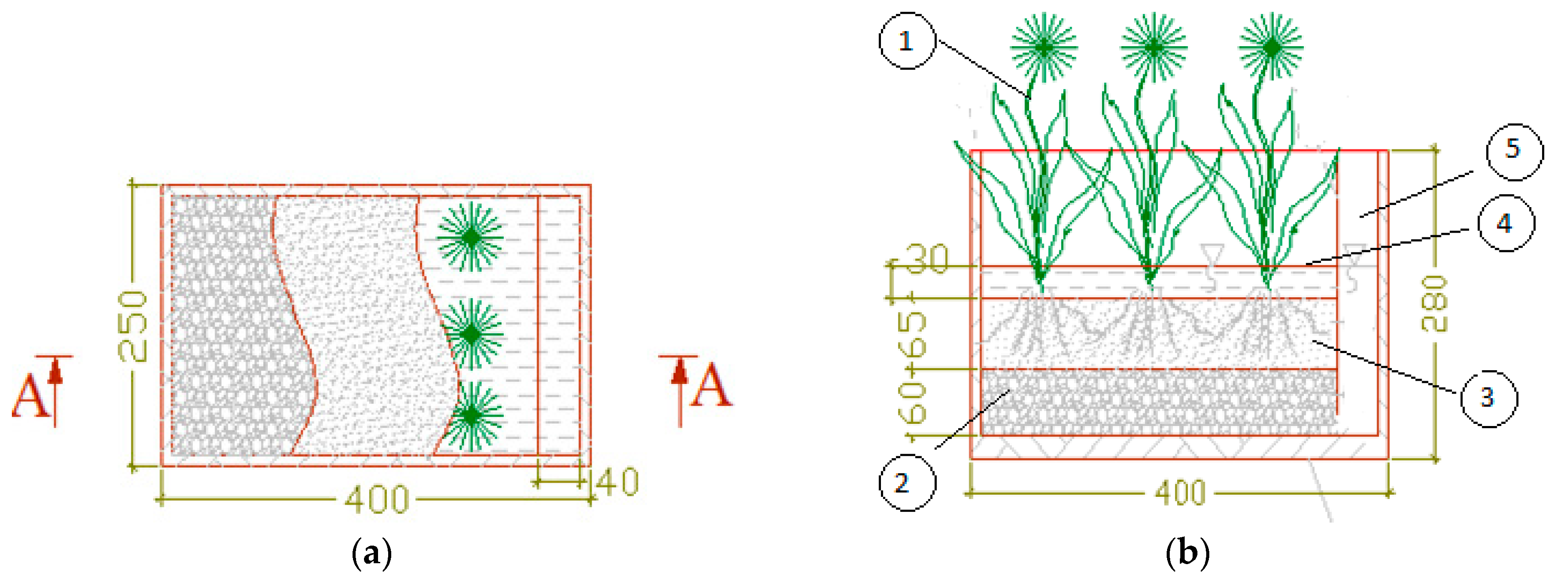
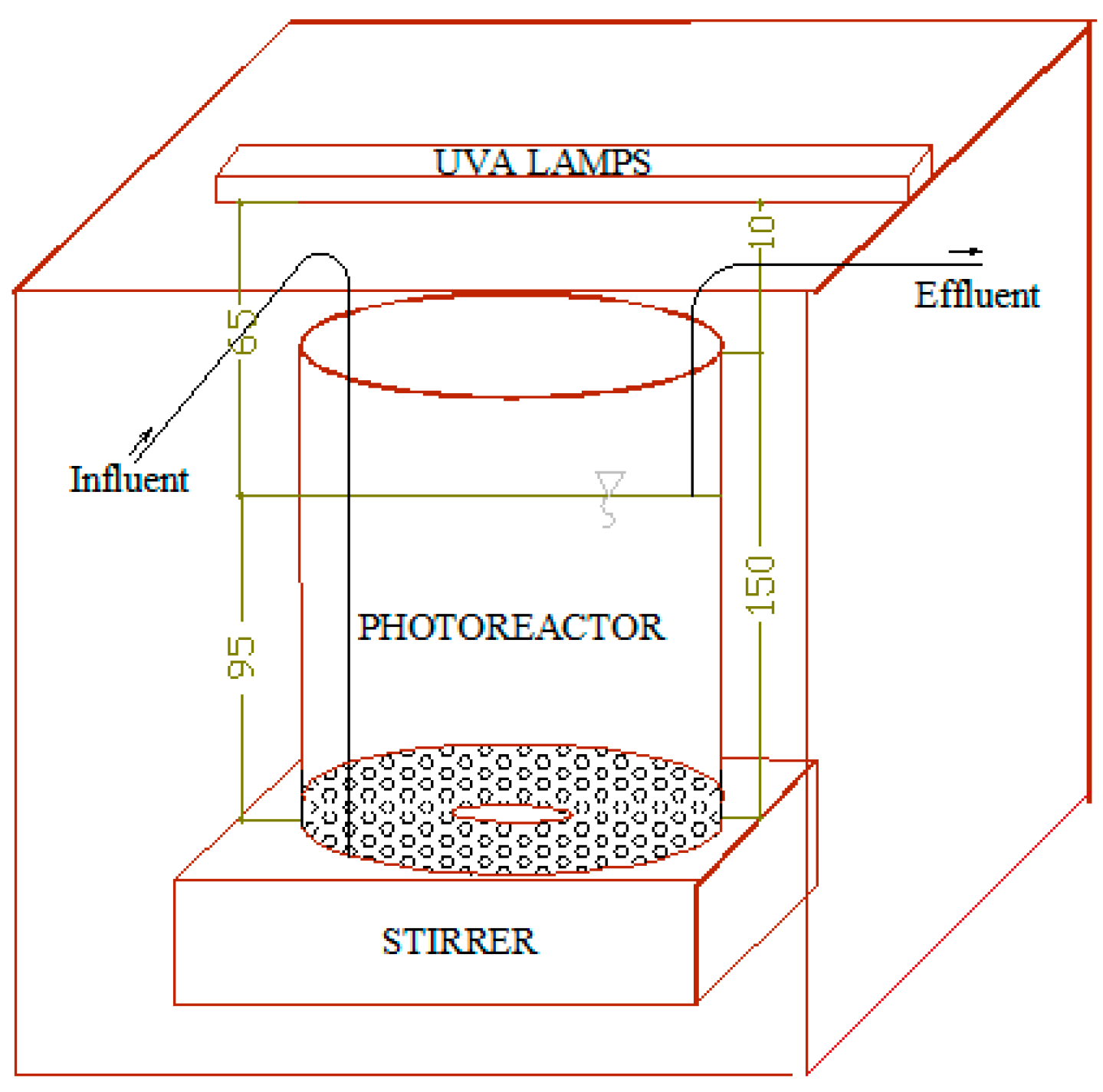


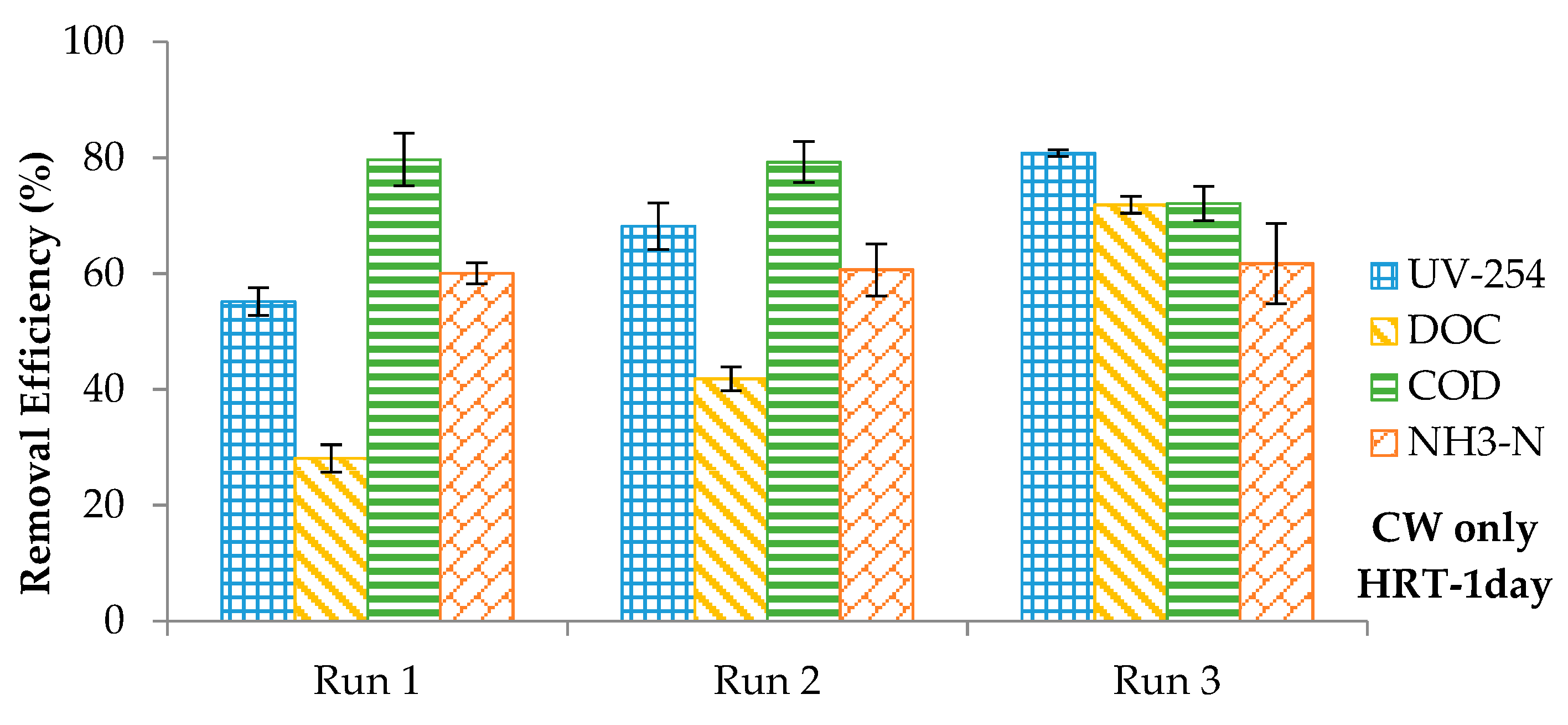
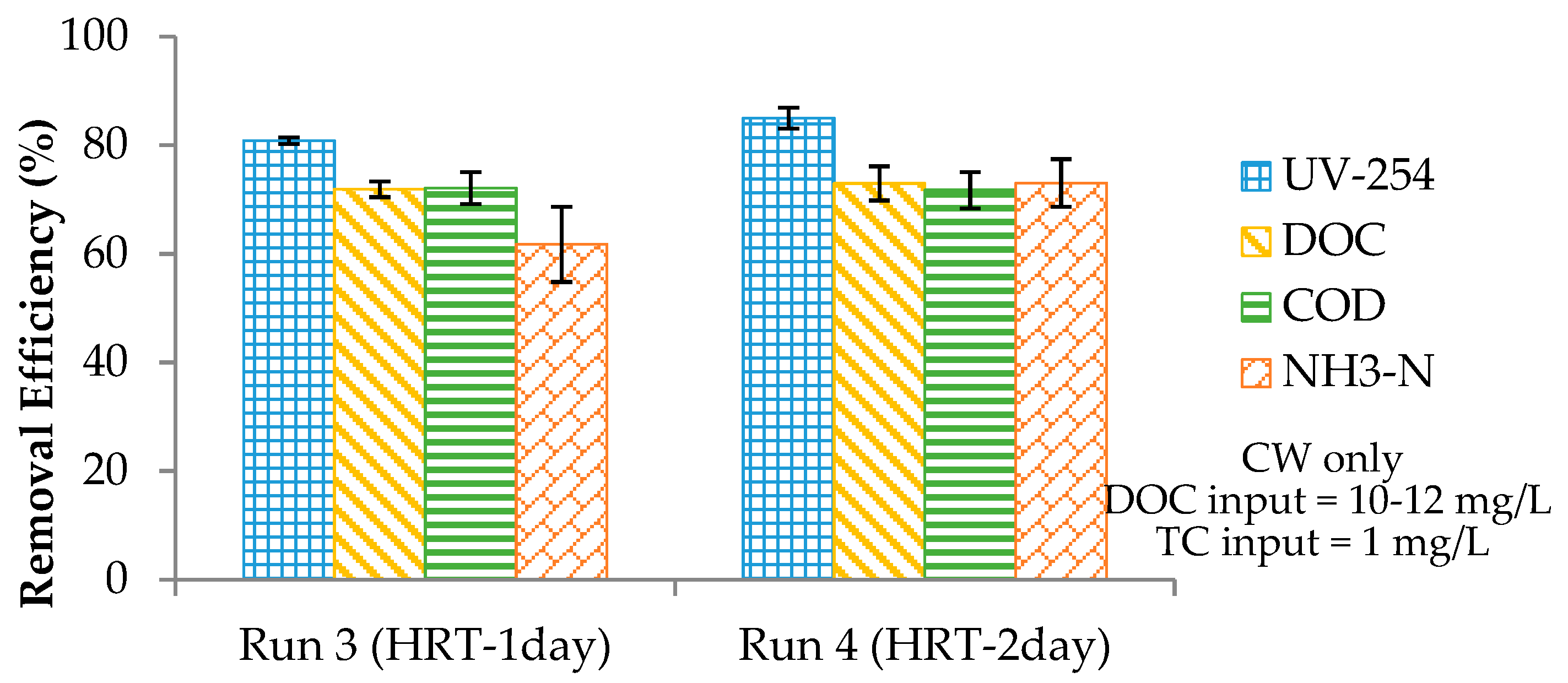
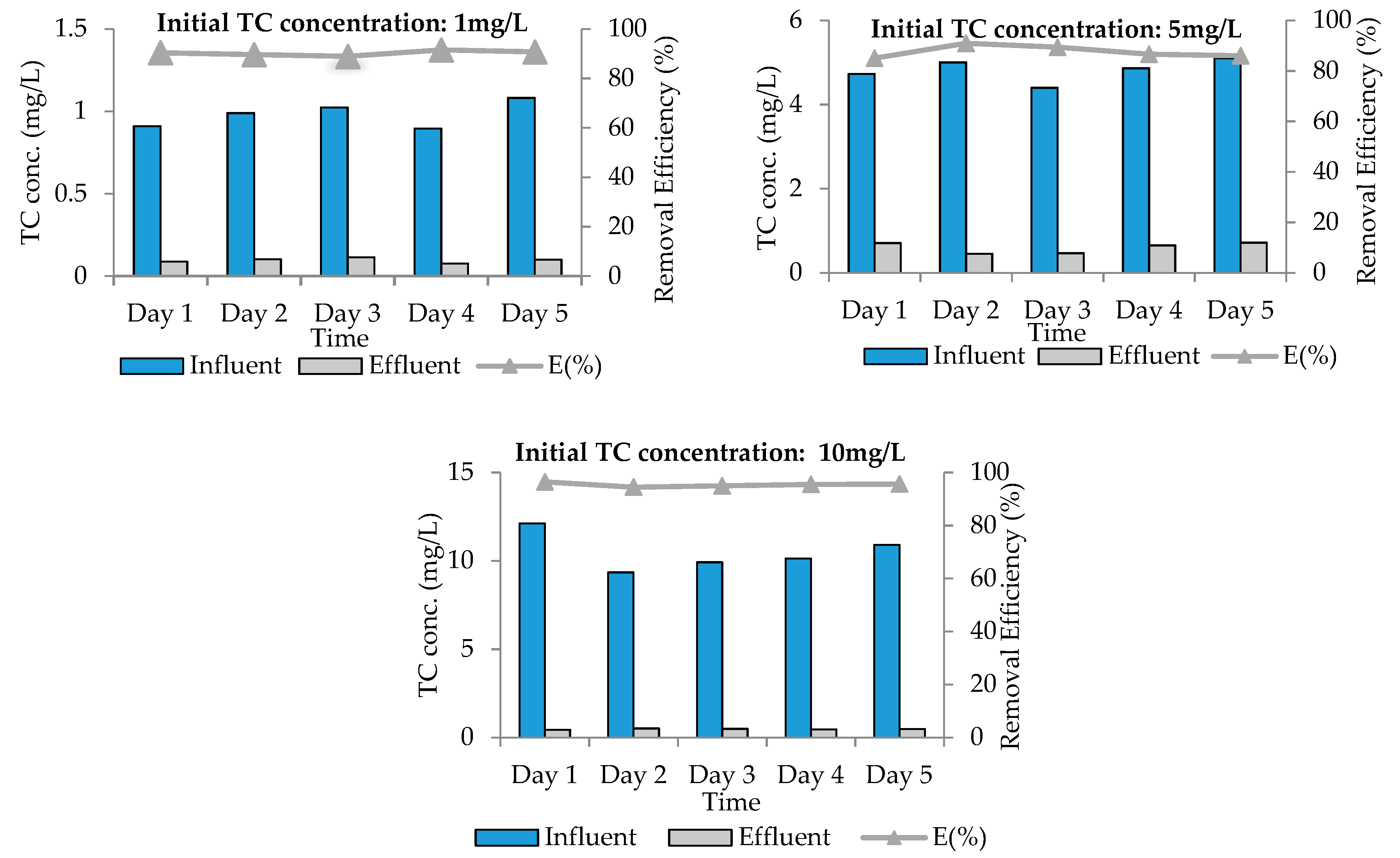
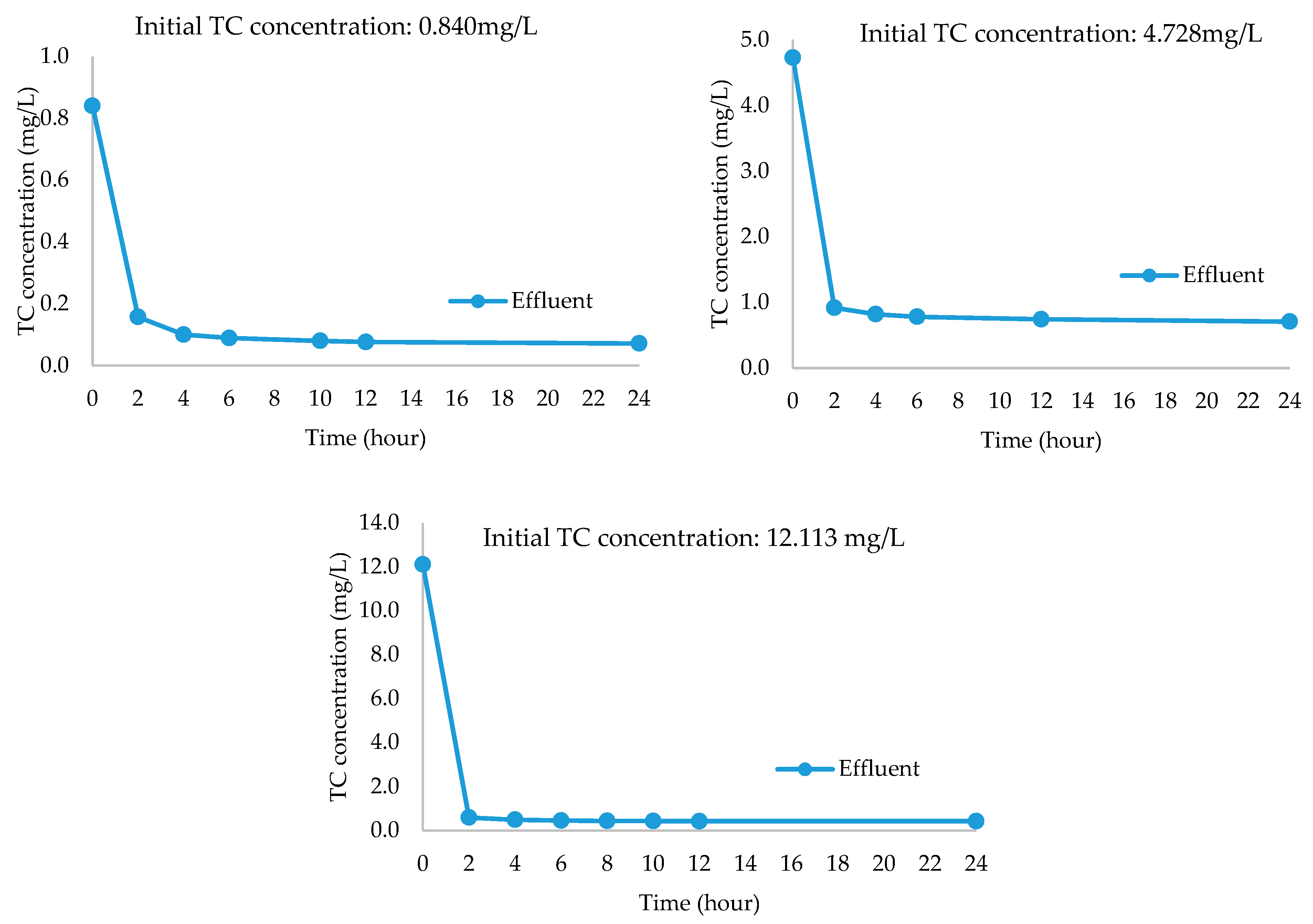
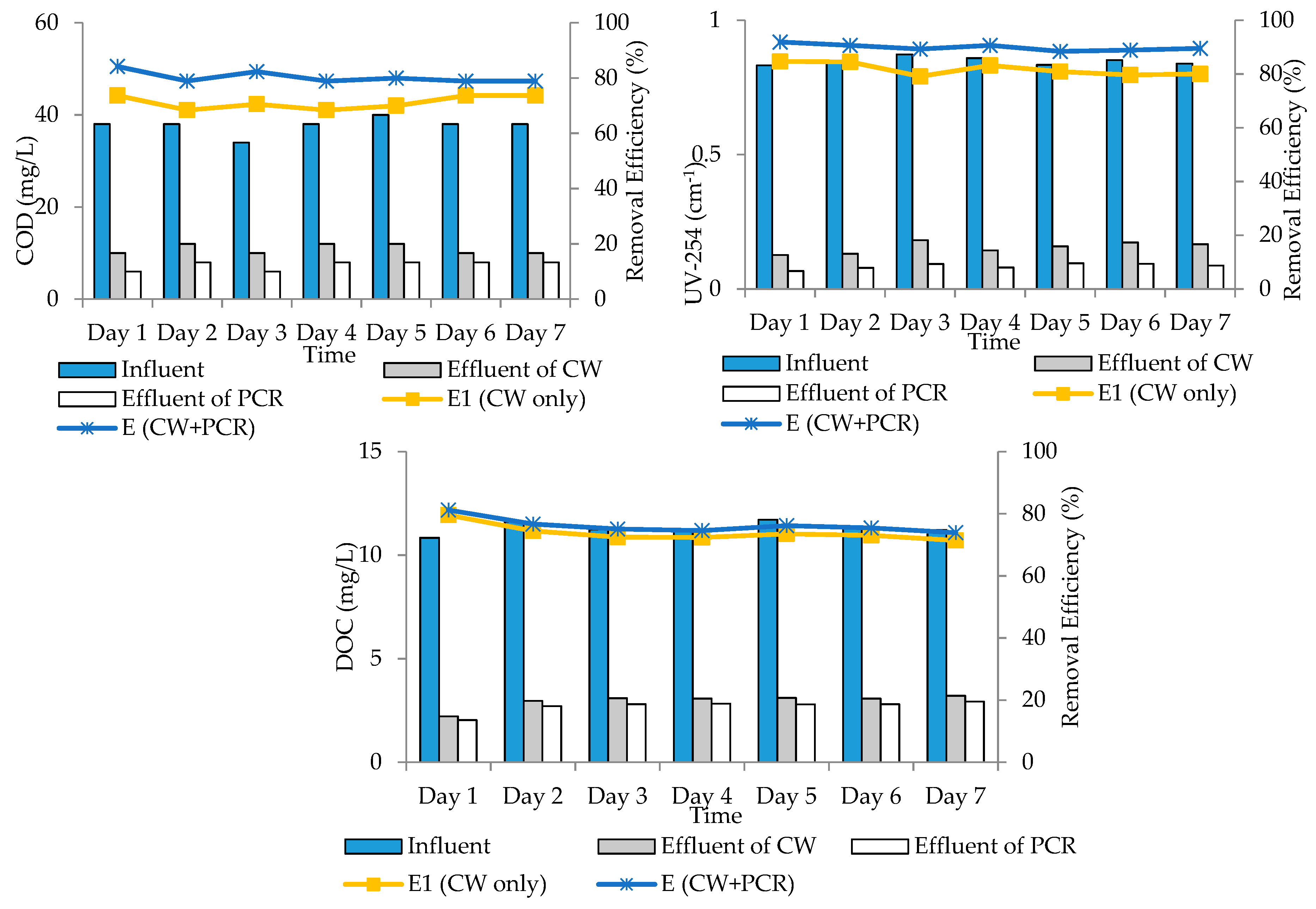
| Parameter | Unit | Raw Water |
|---|---|---|
| pH | - | 7.50 ± 0.52 |
| Alkalinity | mgCaCO3/L | 88.75 ± 5.00 |
| UV-254 | cm−1 | 0.089 ± 0.030 |
| DOC | mg/L | 3.19 ± 0.64 |
| sCOD | mg/L | 8 ± 2 |
| NH3-N | mg/L | 0.127 ± 0.017 |
| PO4-P | mg/L | 0.024 ± 0.011 |
| NO3-N | mg/L | 0.72 ± 0.25 |
| Tetracycline | mg/L | Not detected |
© 2019 by the authors. Licensee MDPI, Basel, Switzerland. This article is an open access article distributed under the terms and conditions of the Creative Commons Attribution (CC BY) license (http://creativecommons.org/licenses/by/4.0/).
Share and Cite
Nguyen, H.T.T.; Chao, H.-R.; Chen, K.-C. Treatment of Organic Matter and Tetracycline in Water by Using Constructed Wetlands and Photocatalysis. Appl. Sci. 2019, 9, 2680. https://doi.org/10.3390/app9132680
Nguyen HTT, Chao H-R, Chen K-C. Treatment of Organic Matter and Tetracycline in Water by Using Constructed Wetlands and Photocatalysis. Applied Sciences. 2019; 9(13):2680. https://doi.org/10.3390/app9132680
Chicago/Turabian StyleNguyen, Hong Thi Thu, How-Ran Chao, and Kuan-Chung Chen. 2019. "Treatment of Organic Matter and Tetracycline in Water by Using Constructed Wetlands and Photocatalysis" Applied Sciences 9, no. 13: 2680. https://doi.org/10.3390/app9132680
APA StyleNguyen, H. T. T., Chao, H.-R., & Chen, K.-C. (2019). Treatment of Organic Matter and Tetracycline in Water by Using Constructed Wetlands and Photocatalysis. Applied Sciences, 9(13), 2680. https://doi.org/10.3390/app9132680






